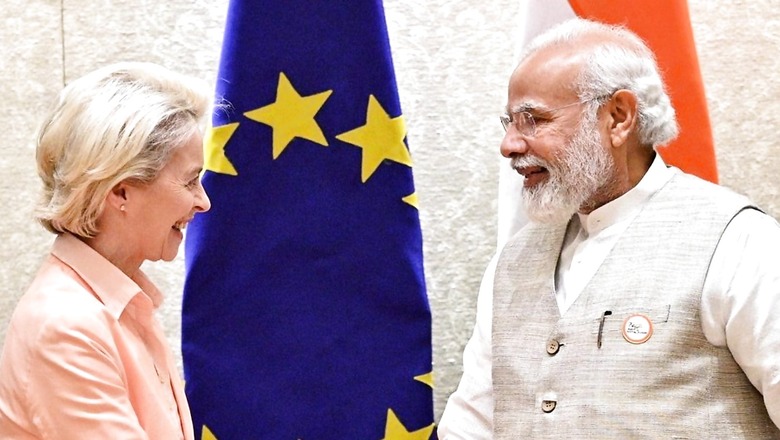
views
Global trade and stronger collaboration between countries play a major role in advancing technology trade and accessibility. The current geopolitical tension, such as China’s aggressive behaviour during the Covid-19 pandemic and the Russian invasion of Ukraine, has created a shroud of uncertainty for states sharing critical technologies. States may now face impediments when trying to improve technology trade. Globalisation has heightened the potential for both global technology trade and restrictions that can also hamper technology dissemination.
As technology remains a critical factor in advancing countries’ economies, there is also a quest for improving the accessibility of these critical technologies. The recently announced Europe-India Trade and Technology Council (TTC) Agreement is an attempt to have easier access of key technologies to both actors. The agreement seeks to improve the cross-border flow of technology goods and services between the two entities.
Identifying potential areas of technology collaboration between India and Europe is a key part of the agreement to build on their comparative advantages and address their flaws in certain key technology sectors. Another area of focus would be the existing and potential trade barriers that might impact the agreement. These barriers need to be addressed if the agreement can yield tangible results for the growth of the technology sector in India and Europe.
Restrictions on Human Capital Movement
Efficient trade policies facilitate the cross-border movement of goods and services in a supply chain. In the capital and labour-intensive technology sector, both high-skilled and low-skilled workers are required in different areas of the value chain.
Today, easy movement of labour across countries is a challenge. With many emerging economies facing dire economic situations due to the Covid-19 pandemic, there is a shortage of skilled workers ready to relocate to another country. The per capita income of India remains on the lower end of the spectrum compared to technological powerhouses like the US and China. Attracting skilled workers from these countries will require additional financial support from the government as well as a favourable investment climate. With increased economic protectionism around the world, the trade of skilled labour for the technology sector will face constraints.
Fears of Weaponisation
Recent events, including the Covid-19 pandemic and the Russia-Ukraine conflict, have raised geopolitical and geo-economic concerns about critical technology supply chains. They have also raised fears about the use of certain technologies to weaponise their respective militaries. These developments can lead to an increase in techno-nationalist tendencies across regions.
Fear of weaponising certain critical technologies can also result in tighter investment screening mechanisms.
Financing that might originate from unverified sources and other potential investors might be viewed with increased scepticism. These developments can impede industry growth including investments in the high-tech sector and hamper technology trade.
Export Control Mechanisms
When technologies are used to build defence and military systems, dual-use application applies and can trigger export regulations and restrictions, as per multilateral conventions such as the Wassenaar Arrangement. Like nuclear technology, this attaches a component or threat of proliferation, which makes the technology liable to certain export controls. Put in place to prevent the excessive exports of dual-use technologies, the Wassenaar Arrangement’s 42 signatories include the US, Japan, Netherlands, and South Korea.
According to the list, export controls on specific technologies have been divided into five categories: materials, software, technical data, and two covering physical commodities. The list of products specifies more than 500 technology products and more than 150 types of critical technology manufacturing equipment.
There is also the possibility of unilateral controls on the export of emerging technologies by countries. The best example is the United States’ Export Control Reform Act (ECRA 2018), which identifies export controls essential for technologies directly related to the country’s national security.
According to this Act, the Department of Commerce’s Bureau of Industry and Security has the authority to update the Export Administration Regulations. Unilateral controls by a technology giant such as the US can hamper the chances of other countries to access critical materials and equipment in the technology sphere.
Import Restrictions
Import restrictions also still exist in many economies, including India. After the government announced the semiconductor package in December 2021, the Indian Cellular and Electronics Association, an industry body made of the leaders of major domestic firms, reminded that the rates for semiconductor imports remain high and certain restrictions remain in the form of high tariffs and sensitive technologies. The statement also emphasised how this would negate the benefits offered by the fiscal support package.
Import restrictions can continue to hamper the growth of India’s technology industry and prevent free technology trade. The government should prioritise unilaterally reducing import tariffs for critical technology components. While there are now financial incentives to set up shop in India, efficient operations require a constant inflow of essential goods at lower prices. Restructuring import rules and regulations to facilitate such an outcome is the first step.
The Europe-India TTC Agreement is a positive step for the country to integrate itself into the global technology supply chains and improve its bilateral trade relations with the European Union (EU). But technology trade remains a convoluted road to navigate with many existential roadblocks. If India and the EU can prioritise to develop a strategy to circumvent existing bottlenecks, then the agreement can reap huge dividends for both parties. This remains critical especially for a rising technological power like India.
Arjun Gargeyas is a research analyst at Takshashila Institution. The views expressed in this article are those of the author and do not represent the stand of this publication.
Read all the Latest News , Breaking News , watch Top Videos and Live TV here.




















Comments
0 comment